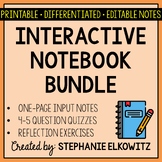Animal Adaptations Interactive Notebook Unit | Editable Notes
- Zip
What educators are saying
Also included in
- SAVE 30% by purchasing ALL my Life Science Interactive Notebook Units! EDITABLE Input Notes Included!About this ProductThis differentiated unit bundle includes 16 INB units. Each unit is composed of INB lessons organized into chapters. Each chapter includes:• An overview with photos of the completedPrice $163.80Original Price $234.00Save $70.20
- SAVE 40% by purchasing ALL my PRINTABLE Interactive Notebook Units! EDITABLE Input Notes Included!About this ProductThis differentiated unit bundle includes 47 INB units. Each unit is composed of INB lessons organized into chapters. Each chapter includes:• An overview with photos of the completed INPrice $344.40Original Price $574.00Save $229.60
- Save 40% by purchasing ALL my Animal Adaptations teaching materials!Important Notes:• Download a FREE Unit Bundle to learn more about all my products.• Save $$$ with the Life Science Complete Curriculum• Save $$$$ with the Integrated Science Complete Curriculum• Consider Daily Lessons as an economicPrice $88.20Original Price $147.00Save $58.80
Description
About this Product
This differentiated unit is composed of interactive notebook lessons organized into chapters. Each chapter includes:
• An overview with photos of the completed INB activity
• One page of input notes (differentiated when necessary)
• At least one INB activity (key included)
• A 4-5 question mini assessment (key included)
• A 2-part reflection exercise
Important Notes:
• Download a FREE Interactive Notebook Unit to learn more about my INB units
• Save $$$ with the Life Science Complete Curriculum
• Save $$$$ with the Integrated Science Complete Curriculum
*********************************************************************************************************
EDITABLE INPUT NOTES
• 100% one-page EDITABLE copies of input notes are included
• Notes are saved as a single .docx file that opens with Microsoft Word & Google Docs
• Editable notes are written in font compatible with Microsoft Word & Google Docs
*********************************************************************************************************
Topics Covered:
Chapter 1: Types of Animals
Chapter 2: Animal Needs
Chapter 3: External Animal Parts
Chapter 4: Types of Adaptations (Physical vs. Behavioral)
Chapter 5: Aquatic Animal Adaptations
Chapter 6: Feeding Adaptations
Chapter 7: Locomotion Adaptations
Chapter 8: Body Covering Adaptations
Chapter 9: Defense Adaptations
Chapter 10: Winter Adaptations
Chapter 11: Extreme Environment Adaptations
Chapter 12: Instincts vs. Learned Behavior
Chapter 13: Behavioral Adaptations Pt 1
Chapter 14: Behavioral Adaptations Pt 2
Chapter 15: Seasonal Behavior
Chapter 16: Life Cycle Adaptations
Chapter 17: Animal Intelligence
Chapter 18: Animal Communication
Chapter 19: Thermoregulation
Chapter 20: Endotherms vs. Ectotherms
Additional Info:
-Topics are differentiated for upper elementary and intermediate grades.
-Topics are differentiated with a color and shape code.
-Two pages of generic and self-assessment reflection prompts are included.
NGSS Alignment
• This resource supports NGSS 3-LS2-1, 3-LS4-2, 3-LS4-3, 4-LS1-1 and MS-LS1-4.
• Refer to my Free Curriculum Support Materials to help incorporate INB lessons into a NGSS aligned curriculum.
TERMS OF USE
• All rights reserved by Stephanie Elkowitz.
• This product is to be used by the original purchaser only.
• Intended for classroom and personal use only.
• Copying for more than one teacher, classroom, department, school, or school system is prohibited.
• This product may not be distributed or displayed digitally for public view.
• Failure to comply is a copyright infringement and a violation of the Digital Millennium Copyright Act (DMCA).





